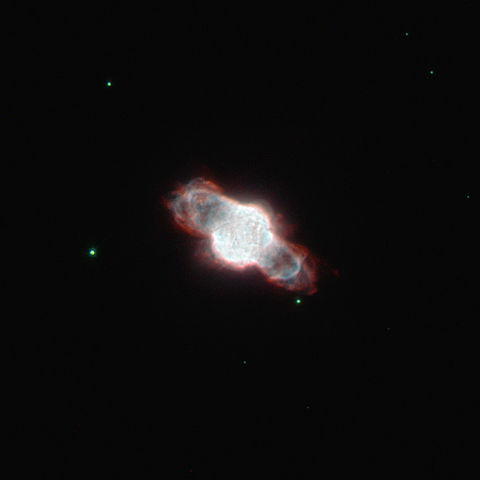 |
This is a file from the Wikimedia Commons. Information from its description page there is shown below.
Commons is a freely licensed media file repository. You can help.
|
Summary
| Description |
English: Astronomers have used the NASA/ESA Hubble Space Telescope to image the tiny planetary nebula NGC 6886. These celestial objects signal the final death throes of mid-sized stars (up to about eight times the mass of the Sun); when such a star exhausts its supply of hydrogen fuel, the outer layers begin to expand and cool, which creates an envelope of gas and dust that shrouds the dying star. However, the star doesn't go down without a fight, finding alternative ways to prevent it from collapsing under its own gravity and emerging as a white dwarf. In the process, the star's surface temperature increases and it is eventually hot enough to emit strong ultraviolet radiation and make the cocoon of gas glow as a stunning planetary nebula.Stellar death isn't quick and painless: the planetary nebula stage typically lasts several tens of thousands of years. By studying the elements that are present in the nebula today, astronomers can determine the original chemical make-up of the star. Studies suggest that the star belonging to NGC 6886 may have originally been similar to the Sun, containing similar quantities of carbon, nitrogen and neon, although heavier elements, such as sulphur, were less plentiful.
Keen amateur astronomers with mid-level telescopes will find it a rewarding challenge to track down NGC 6886 in the small constellation of Sagitta. It is tiny, but not particularly faint: high magnification, a good chart, a dark site and averted vision are needed to spot this elusive celestial jewel. This picture was created by combining images taken using the Wide Field Planetary Camera 2 on Hubble. Filters that let through emission from ionised nitrogen gas (F658N, coloured red), ionised oxygen (F502N, coloured blue) and a broadband yellow filter (F555W, coloured green, and also contributing to the blue) were used. The exposure times were 700 s, 600 s and 320 s respectively. The field of view is merely 30 arcseconds across.
|
| Date |
10 January 2011 |
| Source |
http://www.spacetelescope.org/images/potw1102a/ |
| Author |
ESA/Hubble & NASA |
Permission
( Reusing this file) |
| Public domainPublic domainfalsefalse |
 |
This file is in the public domain because it was created by NASA and ESA. NASA Hubble material (and ESA Hubble material prior to 2009) is copyright-free and may be freely used as in the public domain without fee, on the condition that only NASA, STScI, and/or ESA is credited as the source of the material. This license does not apply if ESA material created after 2008 or source material from other organizations is in use.
The material was created for NASA by Space Telescope Science Institute under Contract NAS5-26555, or for ESA by the Hubble European Space Agency Information Centre. Copyright statement at hubblesite.org or 2008 copyright statement at spacetelescope.org. For material created by the European Space Agency on the spacetelescope.org site since 2009, use the {{ ESA-Hubble}} tag. |
|
|
Licensing

 |
This file is licensed under the Creative Commons Attribution 3.0 Unported license. |
|
|
|
- You are free:
- to share – to copy, distribute and transmit the work
- to remix – to adapt the work
- Under the following conditions:
- attribution – You must attribute the work in the manner specified by the author or licensor (but not in any way that suggests that they endorse you or your use of the work).
http://creativecommons.org/licenses/by/3.0 CC-BY-3.0 Creative Commons Attribution 3.0 truetrue
|
File usage
The following pages on Schools Wikipedia link to this image (list may be incomplete):
Through Schools Wikipedia, SOS Children has brought learning to children around the world. SOS Children's Villages helps those who have nothing and no one, giving them back the famly they have lost and bringing them the very best opportunities for a happy, healthy future. Help another child by taking out a sponsorship



